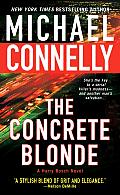 This book review was originally published in the Virginian-Pilot and Ledger-Star on May 22, 1994.
This book review was originally published in the Virginian-Pilot and Ledger-Star on May 22, 1994.
LAPD detective Harry Bosch is the subject of a civil suit claiming that he killed the wrong man during his investigation of rapist and serial murderer the Dollmaker. Bosch has no doubts that he cornered the right man four years ago when he shot suburban family man Norman Church in apparent self-defense. And yet how can he explain the fact that four years later, another corpse has turned up buried in concrete, murdered in the same fashion as the Dollmaker’s victims?
In The Concrete Blonde, Edgar Award-winning novelist Michael Connelly has a sharp eye for plotting and a perceptive ear for dialogue. Unfortunately, he doesn’t possess much of a sense for originality. Connelly fills his novel with predictable twists which come at regularly scheduled intervals, and the struggle between brooding Vietnam vet Hieronymus “Harry” Bosch and plaintiff’s attorney Honey Chandler is dull to the core.
Connelly does hint at some interesting themes in The Concrete Blonde — the moral decay of Los Angeles, the lack of justice in the justice system, and our inability to know what our friends and neighbors are really like — but the author’s hackneyed prose isn’t a competent enough vehicle for bringing out such ideas. Instead we get clichéd descriptions of Bosch’s dark side, including a passage about how his muscular physique was “not created on machines but by lifting the day-to-day weight of his life, his mission.”